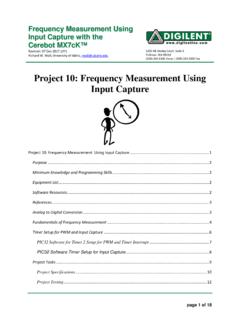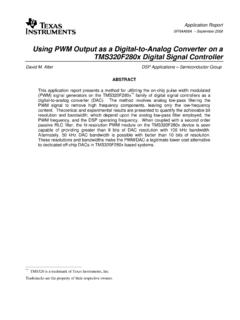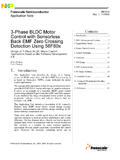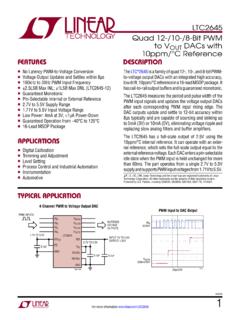Transcription of Section 14. Motor Control PWM - Microchip …
1 2007-2012 Microchip Technology 14-1 Motor Control PWM14 Section 14. Motor Control PWMHIGHLIGHTSThis Section of the manual contains the following major Introduction .. Features of the MCPWM1 Features of the MCPWM2 Register Descriptions .. Special Function Registers .. MCPWM Module Architecture MCPWM Module Operating PWM Clock Time Base PWM output State PWM output Duty Cycle Register Buffering .. PWM Duty Cycle PWM Dead Time Control .. PWM Fault Handling .. Special Features of the MCPWM Module .. Operation in Power-Saving Modes .. Register Maps .. Related Application Revision History .. 14-53dsPIC33F/PIC24H Family Reference ManualDS70187E-page 14-2 2007-2012 Microchip Technology INTRODUCTIONThis Section describes the Motor Control PWM (MCPWM) peripheral in the dsPIC33F/PIC24 Hfamily of of the MCPWM ModuleThe MCPWM is used to generate a periodic pulse waveform, which is useful in Motor and powercontrol applications.
2 The MCPWM module acts as a timer to count up to a period count time period and the duty cycle of the pulses are both on the device, there are up to two MCPWM modules, MCPWM1 and MCPWM2, inthe dsPIC33F/PIC24H family of devices. The features of these two modules are listed Features of the MCPWM1 Module and Features of the MCPWM2 Module . FEATURES OF THE MCPWM1 MODULEThe MCPWM1 module is used to generate multiple synchronized pulse-width modulatedoutputs. The following Motor and power Control applications are supported by the MCPWM1module: Three-phase AC Induction Motor (ACIM) Switched Reluctance Motor Brushless DC (BLDC) Motor Uninterruptible Power Supply (UPS)The distinctive features of the MCPWM1 module are summarized below: Up to eight PWM outputs with four duty cycle generators Dedicated time base that supports TCY/2 PWM edge resolution On-the-fly PWM frequency changes Hardware dead time generators output pin polarity programmed by device Configuration bits Multiple operating and output modes.
3 - Single event mode- Edge-aligned mode- Center-aligned mode- Center-aligned mode with double updates- Complementary output mode- Independent output mode Manual override register for PWM output pins Duty cycle updates that can be configured to be immediate or synchronized to the PWM Up to two hardware fault input pins with programmable function Special Event Trigger for synchronizing analog-to-digital conversions output pins associated with the PWM can be individually enabledNote:This family reference manual Section is meant to serve as a complement to devicedata sheets. Depending on the device, this manual Section may not apply to alldsPIC33F/PIC24H consult the note at the beginning of the Motor Control PWM chapter inthe current device data sheet to check whether this document supports the deviceyou are data sheets and family reference manual sections are available fordownload from the Microchip Worldwide Web site at: :Depending on the dsPIC33F/PIC24H device, there are different versions of theMCPWM1 module.
4 Refer to the Motor Control PWM chapter in the specificdevice data sheet for more information. 2007-2012 Microchip Technology 14-3 Section 14. Motor Control PWMM otor Control FEATURES OF THE MCPWM2 MODULEThe MCPWM2 module provides a pair of complementary PWM outputs, which are useful in thefollowing applications: Independent Power Factor Correction (PFC) in a Motor system Induction cooking systems Direct Current (DC) Motor Control systems Single-phase inverter Control Single-phase ACIM controlThe distinctive features of the MCPWM2 module are summarized below: Two PWM outputs with one duty cycle generator Dedicated time base that supports TCY/2 PWM edge resolution On-the-fly PWM frequency changes Hardware dead time generator output pin polarity programmed by device Configuration bits Multiple output and operating modes.
5 - Single event mode- Edge-aligned mode- Center-aligned mode- Center-aligned mode with double updates- Complementary Operating mode Manual override register for PWM output pins Duty cycle updates that can be configured to be immediate or synchronized to the PWM A hardware fault input pin with programmable function Special Event Trigger for synchronizing analog-to-digital conversions output pins associated with the PWM that can be individually enabledNote:The MCPWM2 module is present only in specific dsPIC33F/PIC24H devices. Referto the Motor Control PWM chapter in the specific device data sheet for Family Reference ManualDS70187E-page 14-4 2007-2012 Microchip Technology REGISTER DESCRIPTIONSThe following registers are used to Control the operation of the MCPWM1 and MCPWM2modules: PxTCON: PWM Time Base Control Register This register is used for the selection of Time Base mode, time base input clock prescaler,time base output postscaler, and for enabling the time base timer.
6 PxTMR: PWM Time Base Register The time base count value and the time base count direction status are obtained in thisregister. PxTPER: PWM Time Base Period Register The PWM time base value is written into this register, which determines the PWM operatingfrequency. PxSECMP: Special Event Compare Register This register provides the compare value at which the analog-to-digital conversions are tobe synchronized with the PWM time base. Comparison can be either during up-count ordown-count in Center-aligned mode depending on the setting of the SEVTDIR bit in thisregister. PWMxCON1: PWM Control Register 1 Selection of either Independent or Complementary mode for each PWM I/O pair isperformed in this register. PWMxCON2: PWM Control Register 2 This register provides the following selections:- Selection of a PWM Special Event Trigger output postscaler value- Immediate updating of duty cycle registers- Selection of output override synchronization with the time base- Enabling updates from duty cycle and period buffer registers PxDTCON1: Dead Time Control Register 1 The dead time value and clock period prescaler for Dead Time Unit A and Dead Time UnitB can be selected using this register.
7 PxDTCON2: Dead Time Control Register 2 Dead time insertions from Dead Time Unit A or Dead Time Unit B for each of the PWMoutputs can be selected using this register. PxFLTACON: Fault A Control Register This register provides the following selections:- PWM output pin driven on an external fault active or inactive state- Fault mode Cycle-by-Cycle mode or Latched mode- Pin pair to be controlled or not controlled by Fault Input A PxFLTBCON: Fault B Control Register This register provides the following selections:- PWM output pin driven on an external fault active or inactive state- Fault mode Cycle-by-Cycle mode or Latched mode- Pin pair to be controlled or not controlled by Fault Input B PxOVDCON: Override Control RegisterThis register is used for enabling the output override feature and for PWM output pin controlselection.
8 PxDC1: PWM Duty Cycle Register 1 The 16-bit PWM duty cycle value for the PWM output pair 1 is written into this :The letter x in the register names refers to the MCPWM module number. 2007-2012 Microchip Technology 14-5 Section 14. Motor Control PWMM otor Control PWM14 PxDC2: PWM Duty Cycle Register 2 The 16-bit PWM duty cycle value for the PWM output pair 2 is written into this register. PxDC3: PWM Duty Cycle Register 3 The 16-bit PWM duty cycle value for the PWM output pair 3 is written into this register. PxDC4: PWM Duty Cycle Register 4 The 16-bit PWM duty cycle value for the PWM output pair 4 is written into this register. PWMxKEY: PWM Unlock Register This register enables the user to unlock the PWMxCON1, PxFLTACON and PxFLTBCON registers for write access.
9 FPOR: POR Device Configuration RegisterIn addition to the Special Function Registers (SFRs) associated with the MCPWM module,three device Configuration bits can be used to set up the initial Reset states and polarity ofthe PWM I/O pins. These device Configuration bits are located in the FPOR register. FOSCSEL: Oscillator Source Selection RegisterIn addition to the SFRs associated with the MCPWM module, one device Configuration bitin this register can be used to set up the write-protect feature of the PWM Family Reference ManualDS70187E-page 14-6 2007-2012 Microchip Technology SPECIAL FUNCTION REGISTERSR egister 14-1:PxTCON: PWM Time Base Control RegisterR/W-0U-0R/W-0U-0U-0U-0U-0U-0 PTEN PTSIDL bit 15bit 8R/W-0R/W-0R/W-0R/W-0R/W-0R/W-0R/W-0R/W- 0 PTOPS<3:0>PTCKPS<1:0>PTMOD<1:0>bit 7bit 0 Legend:R = Readable bitW = Writable bitU = Unimplemented bit, read as 0 -n = Value at POR 1 = Bit is set 0 = Bit is clearedx = Bit is unknownbit 15 PTEN: PWM Time Base Timer Enable bit1 = PWM time base is on0 = PWM time base is offbit 14 Unimplemented.
10 Read as 0 bit 13 PTSIDL: PWM Time Base Stop in Idle Mode bit1 = PWM time base halts in CPU Idle mode0 = PWM time base runs in CPU Idle modebit 12-8 Unimplemented: Read as 0 bit 7-4 PTOPS<3:0>: PWM Time Base output Postscale Select bits1111 = 1:16 postscale 0001 = 1:2 postscale0000 = 1:1 postscalebit 3-2 PTCKPS<1:0>: PWM Time Base Input Clock Prescale Select bits11 = PWM time base input clock period is 64 TCY (1:64 prescale)10 = PWM time base input clock period is 16 TCY (1:16 prescale)01 = PWM time base input clock period is 4 TCY (1:4 prescale)00 = PWM time base input clock period is TCY (1:1 prescale)bit 1-0 PTMOD<1:0>: PWM Time Base Mode Select bits11 = PWM time base operates in Continuous Up/Down Count mode with interrupts for double PWM updates10 = PWM time base operates in Continuous Up/Down Count mode01 = PWM time base operates in Single Event mode00 = PWM time base operates in Free Running mode 2007-2012 Microchip Technology 14-7 Section 14.


















